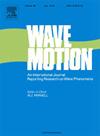Viscoacoustic Gaussian beam inverse scattering imaging method by asymptotic estimation of the single-scattering Hessian operator
IF 2.5
3区 物理与天体物理
Q2 ACOUSTICS
引用次数: 0
Abstract
Attenuation compensation has been introduced in the field of linearized inverse scattering problems for the restoration of geological structures and material properties within viscoacoustic media, which are characterized by P-wave velocity and the quality factor . It relies on the solution of a true-amplitude asymptotic inversion, incorporating a single-scattering propagation operator. Nonetheless, traditional mathematical treatments of asymptotic inversion often overlook the viscous properties of the medium. In this study, we investigate the application of the Gaussian-beam depth migration technique, which takes into account multiple wave arrivals, to address the complexities associated with true-amplitude viscoacoustic inverse scattering. This method presents a precise and adaptable alternative to conventional single-arrival ray-based migration techniques. Our focus is on viscoacoustic inversion imaging using the single-scattering Hessian operator, deemed essential for full waveform inversion. In this situation, we demonstrate how to derive an appropriate weighting filter that allows the dominant part of the weighted Hessian operator to effectively approximate the identity operator. As a result, we develop a new form of pseudoinverse operator linked to the Born modeling operator for a single-beam-center slowness component of the wavefield. This operator facilitates the implementation of viscoacoustic Gaussian beam prestack depth migration on common-shot gathers, thereby offering a robust solution for imaging complex structures where single-arrival ray-based approaches are insufficient. Numerical results derived from the analysis of 2D realistic synthetic datasets substantiate the effectiveness of the proposed methodology. This work not only advances the understanding of viscoacoustic imaging techniques but also significantly enhances their practical application in challenging geological scenarios.
基于单散射Hessian算子渐近估计的粘声高斯波束逆散射成像方法
衰减补偿已被引入到线性化逆散射问题领域,用于恢复以纵波速度和质量因子q为特征的粘声介质中的地质结构和材料性质,它依赖于包含单散射传播算子的真振幅渐近反演的解。然而,传统的渐近反演数学处理往往忽略了介质的粘性特性。在这项研究中,我们研究了高斯波束深度偏移技术的应用,该技术考虑了多次波到达,以解决与真振幅粘声逆散射相关的复杂性。该方法为传统的单点射线迁移技术提供了一种精确且适应性强的替代方法。我们的重点是使用单散射Hessian算子进行粘声反演成像,这对于全波形反演至关重要。在这种情况下,我们演示了如何推导一个适当的加权滤波器,该滤波器允许加权Hessian算子的主导部分有效地近似单位算子。因此,我们为波场的单束中心慢度分量开发了一种与Born建模算子相联系的伪逆算子的新形式。该算子有助于在共射孔集上实现粘声高斯波束叠前深度偏移,从而为单到达射线成像方法不足的复杂结构提供了强大的解决方案。对二维真实合成数据集的数值分析结果证实了所提方法的有效性。这项工作不仅促进了对粘声成像技术的理解,而且大大提高了粘声成像技术在具有挑战性的地质场景中的实际应用。
本文章由计算机程序翻译,如有差异,请以英文原文为准。
求助全文
约1分钟内获得全文
求助全文
来源期刊

Wave Motion
物理-力学
CiteScore
4.10
自引率
8.30%
发文量
118
审稿时长
3 months
期刊介绍:
Wave Motion is devoted to the cross fertilization of ideas, and to stimulating interaction between workers in various research areas in which wave propagation phenomena play a dominant role. The description and analysis of wave propagation phenomena provides a unifying thread connecting diverse areas of engineering and the physical sciences such as acoustics, optics, geophysics, seismology, electromagnetic theory, solid and fluid mechanics.
The journal publishes papers on analytical, numerical and experimental methods. Papers that address fundamentally new topics in wave phenomena or develop wave propagation methods for solving direct and inverse problems are of interest to the journal.
 求助内容:
求助内容: 应助结果提醒方式:
应助结果提醒方式:


